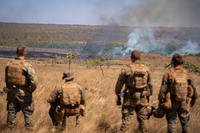CAMP PENDLETON, Calif. – A heat wave, drought and strong winds created the perfect recipe to feed the recent wildfire that spread across Northern Camp Pendleton, Calif., destroying more than 6,000 acres, May 14, 2014.
This early beginning to wildfire season makes the mission of creating firebreaks throughout approximately 120 miles around base more important than ever.
Facilities Maintenance Division and seven Marines with 7th Engineer Support Battalion, 1st Marine Logistics Group, began working toward this goal May 6, 2014 and will continue to cover the vast Camp Pendleton areas through Aug. 10, 2014.
“We do this once a year and it starts at the beginning of May every year,” said Randy Branim, heavy equipment operator who is leading the firebreaks operation with FMD. “The concept is to knock all the brush off and clean it up so it doesn’t allow any fire to jump over it.”
The largest and perhaps the most important firebreaks, which FMD employees and 7th ESB Marines will maintain, encircle the outskirts of Camp Pendleton.
“There’s a perimeter break around almost all of Camp Pendleton,” said Branim. “This ensures the fire won’t go off base.”
Containing these fires to the site in which they originally ignited does more than help ensure the safety of the locals living in the communities that surround the base.
“Once a fire goes off base, we no longer have full control of it and it can do some damage,” said Ruben Salas, transportation mobile equipment operator supervisor, FMD. “Once it’s off base, we also have to pay for the damages, so it saves us millions of dollars a year.”
In addition to the firebreaks that line the base, FMD and 7th ESB will cut out brush surrounding impact areas of the various training ranges.
“It’s important to go around the impact areas of course, because that’s where a lot of the fires on base start,” said Branim. “All it takes is a spark from small arms fire.”
Most of Camp Pendleton’s firebreaks sit on top steep inclines, so creating these large brushless paths that can reach up to 20-feet wide is a hazardous task in itself.
“They sit right on ridgelines on the very top of mountains,” said Branim. “Because of the terrain, the areas can be really rocky. If you’re not paying attention, it could get scary.”
For many of these Marines who will gain the bulk of their experience on this equipment while creating these firebreaks, driving the dozers up some of the steepest peaks on base is a daunting task.
“Trying to make level cuts is probably the hardest part. When you’re coming down hill, you’re coming straight down,” said Lance Cpl. Matthew Brown, engineer equipment operator, Support Company, 7th ESB, 1st MLG. “Climbing up some pretty steep hills in a dozer is scary. You’re going straight up, so all you see is the sky when you’re driving up hill, but level cuts make it so that the fire trucks can have easier access up to a fire in the mountains.”
Danger aside, the 22-year-old Wylie, Texas, native and his peers received a firsthand look at how important their role in maintaining the firebreaks are when the Camp Pendleton blaze caused hundreds of service members and their families to evacuate their on-base homes. According to Salas, some of the firebreaks created earlier this year near the Fallbrook gate played a vital role in containing the fire in that area.
“Ever since [the fire], it makes us feel like our job is just that much more important,” said Lance Cpl. Jordan English, a 20-year-old engineer equipment operator, Support Company, 7th ESB, 1st MLG, of Cedar Rapids, Iowa. “We can slow down a fire to the point of containment. It has a big impact on the entire base’s safety.”
As firefighters and other first responders work to extinguish the flames, FMD halted the creation of firebreaks in certain locations near the affected areas. However, Salas said they are still expected to meet their completion deadline of Aug. 10.
“Marines and civilians are working together to get these firebreaks established,” he added.

























